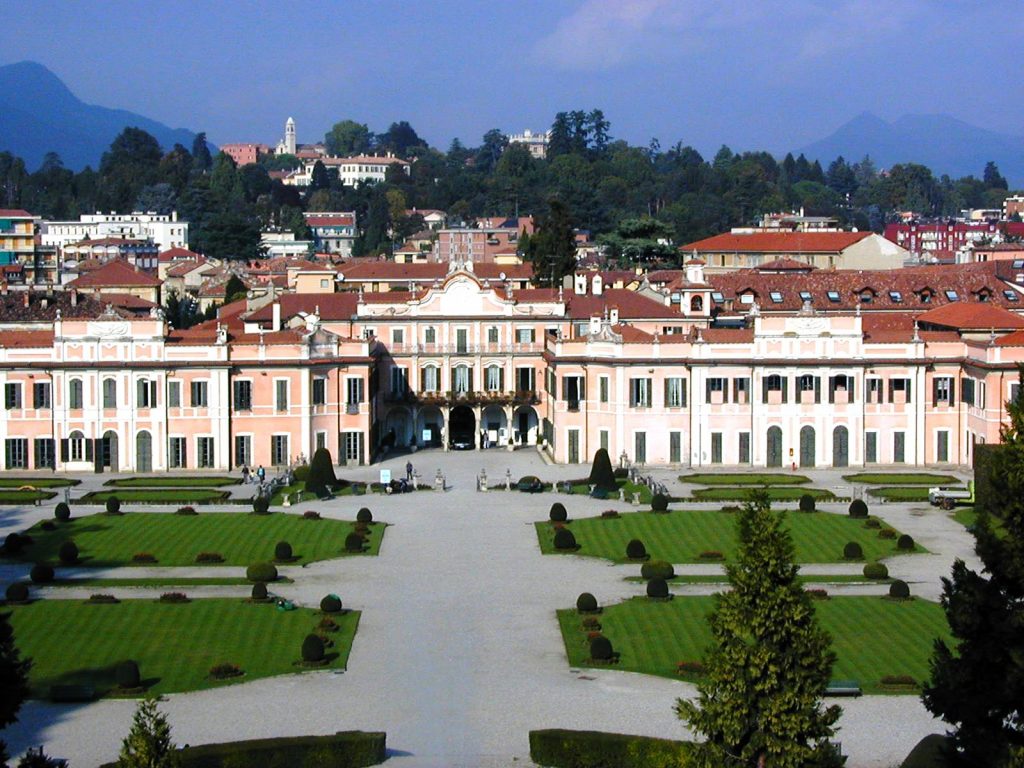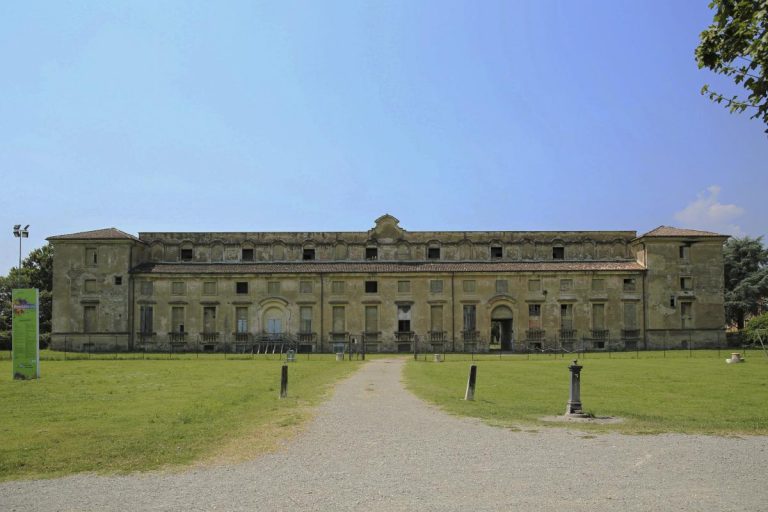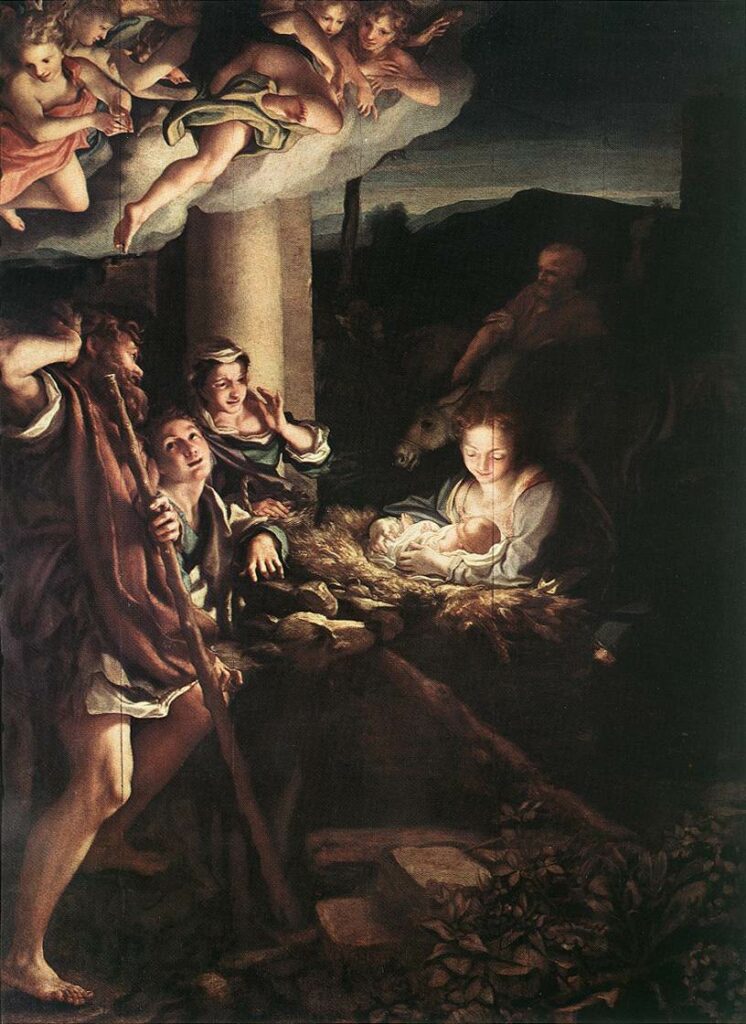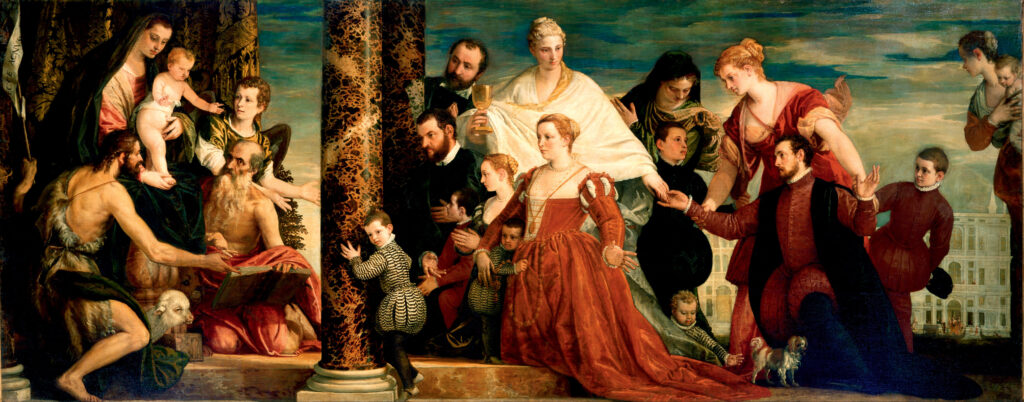His marriage to Carlotta Aglae d’Orléans brought Francesco’s introverted life a multitude of problems and humiliations, so much so that the newlyweds were removed from court to reside in Rivalta. Thanks to the marriage agreement concluded for his son, he acquired the hoped-for access to the Tyrrhenian Sea, for which he had two important roads built between Modena and Massa. Due to the War of Austrian Succession he was forced to leave the Duchy, where he returned after seven years of exile in 1749.
Worries over the succession oppressed the Duke, who concluded a marriage agreement with the Austrian court for his only niece, Maria Beatrice Ricciarda, who was only a few months old. The agreement provided for two different treaties, one concerning the marriage and the other the succession of the Duchy in the hands of an Austrian prince. From that moment Francesco was entrusted with the command of the imperial troops in Italy and, appointed general governor of Lombardy, moved to Milan. The move promoted a profitable cultural exchange by promoting the spread of Enlightenment ideas and the season of reforms in the Este lands: the ‘Estense Code’ is dated 1771 and standardised the regulations in force, representing an advanced and precursor model of legislative treatment for the time. Francesco III was the author of the ‘Dresden Sale’ with which he ceded some 100 of the most prestigious paintings in the Este collection to Augustus III, King of Poland and Elector of Saxony.
The Life and Marriage
Francesco Maria was born in Modena on 2 July 1698, the eldest son of Duke Rinaldo I and Carlotta Felicita of Brunswick-Luneburg.
The young prince’s closed and shadowy character forced him to spend a solitary childhood and his isolation worsened after the death of his mother, with his father making no secret of his fondness for his second son Gianfederico.
The situation became even more complicated when the Duke, in order to obtain protection from France, chose Charlotte Aglae d’Orléans, fourth daughter of the regent of France, Philip of Orleans, as his bride.
In Paris, the negotiations were entrusted to two Este ministers, including Earl Benedetto Selvatico, who, in order to conclude the negotiations more rapidly, did not inform the Duke of the noblewoman’s restlessness and licentious Life, which caused a scandal even in the notoriously open and worldly French court.
The wedding took place on 12 February 1720, but the bride, who was reluctant to leave the luxurious court in Paris, did not arrive at the Este court until 20 June 1721.
The disagreements with Duke Rinaldo and between the newlyweds began immediately: Carlotta’s tempestuous and capricious character could not be contained by Francesco, who became the victim of her cruelty and coldness. She openly demonstrated her revulsion towards him, inflicting her repulsion on his already introverted and unhappy life, to the point that Francesco chose to move away, taking refuge in Bologna.
The seriousness of the situation prompted Duke Rinaldo to take a position, managing to get his son to return to the city after receiving a missive from Carlotta full of good intentions.
But awaiting Francesco was yet another humiliation, as he discovered that his wife and his brother Gianfederico had indulged in mutual attraction. The scandal forced the Duke, in spite of himself, to order his favourite son to abandon the ecclesiastical habit and leave for the court of Emperor Charles VI, where he would learn the craft of arms. To silence the gossip, the couple was sent to live in Reggio, but Carlotta, convinced that she could obtain the annulment of the marriage by persevering in her ‘white marriage’, asked her husband to accompany her to Loreto and from there to Verona, going so far as to propose France as a destination. Francesco, unable to restrain his wife, requested the intervention of Duke Rinaldo and Carlotta’s father, who went so far as to officially forbid his daughter to enter France.
The delicate situation led the couple to live in the Ducal Palace in Sassuolo, but Carlotta, not yet resigned, expressed the desire to travel, attracted by the worldly life that Rome could offer her.
Indeed, in the Eternal City she rediscovered the unruliness and frenzy that she had so much missed, weaving a love affair with the Cardinal of Rohan, which once again led the couple to leave a city full of gossip and backbiting.

The Duke ordered them to take up residence at the Cittadella di Reggio, which soon became a place of entertainment and players among whom the ‘fille de France’ found several admirers. Unexpectedly, news arrived of a rapprochement between the couple and Carlotta’s subsequent pregnancy, but despite this first moment of possible serenity, Francesco, at the height of his endurance, decided to punish the man he believed to be the cause of most of his problems and unhappiness, Count Benedetto Selvatico. In July 1722, he broke into the count’s house in disguise and revealed his identity, threatening him with death with two pistols. Frightened, Selvatico hastily fled the Duchy, taking with him secret documents concerning government matters. Informed of the episode, Duke Rinaldo broke off relations with his son, which were only resumed in 1724, following Francesco’s reading of the submission formula and public request for forgiveness, which his father granted him, holding him in an embrace.
Thanks to his newfound serenity, Rinaldo gave his son and daughter-in-law a large plot of land in Rivalta where there was already a beautiful villa, enlarged and decorated by Prince Borso d’Este, but built in the late 16th century by the Alpi family around a 15th-century tower belonging to the Canossa family. The roles in the couple were reversed: while Carlotta devoted herself to overseeing the extension of the palace and then to her maternity, Francesco began a dense series of amorous relationships. In June 1725 the couple experienced the pain of the death of their eldest son Alfonso, while the following year Maria Teresa was born, leaving the fate of the Duchy in uncertainty until the long-awaited male heir Ercole Rinaldo arrived on 22 November 1727.
Becoming a Duke: Francesco III d’Este
The War of Polish Succession and the subsequent occupation of Modena in 1734 forced the prince to take refuge first in Genoa, then in various European capitals where he established numerous diplomatic relations.
Together with the imperial army, he fought the Turks in Hungary and during his return to Italy he was reached by the news of his father’s death (26 October 1737). On 4 December 1737 Francesco entered Modena ready to assume the government of the Duchy while his wife, who had taken refuge in Paris during the conflict, returned to the Este capital only in 1739.
The couple finally found peace and this conciliation led Francesco to agree to Carlotta’s proposals: contrary to what happened under the strict Duke Rinaldo, the court was enlivened by parties, shows, balls and above all games including the well-known “biribisso”, a game of chance imported from France with which the Duchess entertained herself until dawn.
In 1741 the Duke concluded the agreement for the marriage between his 14-year-old son Ercole Rinaldo and Maria Teresa Cybo Malaspina, the future heiress of the Duchy of Massa and Carrara. The union would allow the Este family to extend their possessions beyond the Apennines, conquering the much desired access to the Tyrrhenian Sea. With this in mind, Francesco commissioned two important roads linking Modena to Massa, the via Vandelli and the via Giardini-Ximenes, which we will discuss later.
In foreign policy, relations with France and Spain were very delicate, especially following the ostentatious attitude of neutrality adopted by his father Rinaldo during his rule, which caused numerous suspicions of political ambiguity towards the Estense state.
The Duke, aware of this situation, on the one hand increased the army by five thousand and on the other increased the number of ambassadors in the various states. The death of Emperor Charles VI (1740) caused the War of the Austrian Succession that also involved Italy, inducing the Duke to abandon his position of neutrality by taking a position in favour of Emperor Charles VII, together with Spain and France, trying however to initially dissimulate his choice to avoid retaliations and to await the arrival of the Spanish army led by the Duke of Montemar. In the meantime, the Austro-Piedmontese army invaded Reggio, on 17 May 1742, while two days later Carlo Emanuele King of Sardinia passed under the walls of Modena with his army to establish himself on the banks of the Panaro river.

The Este’s support for the Emperor did not remain secret for long because the Austro-Piedmontese intercepted a missive from him and, discovering the Duke’s intentions, ordered him to confirm the Este state’s usual neutrality by granting them some strongholds.
Spanish help was slow to arrive and Francesco, fearing harsh reprisals from the Austro-Piedmontese army, insisted on not revealing the existence of the agreement. At the beginning of June the ambiguous position forced him to retreat to the Villa del Catajo near Padua: immediately the enemy troops occupied Modena and conquered the Cittadella on 28th June 1742, while Mirandola was to surrender a month later.
Faced with the tragic situation, the Duke submitted to Spain, declaring his devotion to King Philip V and asking to serve his army in any role, even one below his rank. Francesco was appointed captain general of the troops in Lombardy and participated in several phases of the war including the Battle of Velletri, the taking of Milan and the siege of Ventimiglia. The Peace of Aquisgrana in 1748 put an end to the war and handed the Estense Duchy back to Francesco III, who returned to Modena after seven years of exile, in August 1749, without abandoning the illusion of a future expansion and new-found authority that his State could play on the European chessboard.
The uncertainty over the succession of the Duchy
If the delicate political situation made the alliances and credibility of the Estense Duchy doubtful, the spectre of a future without heirs crept in to worsen the situation, an uncertainty that had more than once compromised the stability of the State. In fact, in 1751 the death of Benedetto, the only male son besides Ercole Rinaldo, complicated the prospect of succession, especially considering the unhappy union between the latter and Maria Teresa Cybo, confirmed by the birth of only one daughter in ten years of marriage.
On this child of only a few months, Maria Beatrice Ricciarda born in 1750, all hope for the future of the lineage was focused. Francesco immediately sought a marriage agreement with the King of England, George II, by requesting a union with one of the sovereign’s grandsons, a proposal that was however ‘passed on’ to the Austrian court, who were happy to consolidate the alliance and their position in Italy.
The opposition of Ercole, father of the betrothed, did not prevent Francesco from pursuing the intense and laborious negotiations that were protracted also due to the interference of France, which tried to obstacle the success of this agreement. The pacts were concluded in May 1753 and two different treaties were signed, one on marriage and the other on succession. The secret part of the latter sanctioned, once the Duchy had passed into the hands of the Austrian prince, the separation between Austria and the Duchy of Este, which would maintain Modena as the capital of the State. The prince was to take the Este surname, reside in the Duchy and, should the opportunity arise for him to ascend the Austrian throne, he was to renounce the Este state in favour of his son or, in the absence of an heir, another member of the family provided that he did not reign in Austria. While Duke Francesco would assume command of the imperial troops and the government of Lombardy until his future son-in-law came of age.
The marriage was celebrated in 1771 in Milan and before that date the name of the groom changed several times: in fact, after the death of Archduke Charles the engagement fell to Leopold who married the daughter of King Charles III of Spain instead, so that he was replaced by his brother Ferdinand, the fourteenth son of Maria Theresa of Austria.
From 1753 Francesco was assigned command of the imperial troops in Italy and, appointed general governor of Lombardy, he moved to Milan, a city experiencing the ferment of reform.

Francesco III the Reformer
If the duke’s residence in Milan brought at least an unusual new feeling to the Este court and to the people, who had little affection for an absentee governor, the cultural exchange between the great Lombard city and Modena was fruitful, promoting in the Este lands the spread of Enlightenment principles and the season of reforms.
Francesco, in the wake of the ‘openings’ he had made so that the State would be fairer and less tied to the clergy (such as the nationalisation of the Studio in 1772, the opening of the Biblioteca Estense Library and the creation of the Albergo dei Poveri) emitted the Estense Code in July 1771. The ‘Code of Laws and Constitutions for the States of his Highness’ was intended to standardise the rules in force and represented an advanced and precursor model of legislative treatment for the time, also with respect to other States. In the part on civil law, where various topics are dealt with, there is a desire to streamline state structures and give coherence to the heterogeneity of existing norms, to put a brake on the economic power of the clergy, to abolish the ecclesiastical forum, to regulate feudal and inheritance law matters and to strengthen the agricultural sector.
In the section on criminal law, on the other hand, a close link remains with traditional conceptions, such as the social diversification of punishments between nobles and non-nobles and the centrality of the figure of the duke, who remained firmly at the top of a state based on a solid hierarchy of power. Although corporal punishment and the death penalty were still present, the Estense Code nevertheless initiated a slight and slow improvement in the conditions of the condemned.

The Last Years of The Life
His wife Carlotta died in 1761 in Paris, a city in which he resided almost continuously, escaping from a Modena that was too small and suffocating for her. After her death, Francesco morganatically united first with Teresa di Castelbarco and later with Renata Teresa, Countess of Harrach. The last years of his life were spent in the ducal villa in Varese, which he commissioned and built between 1766 and 1772. From the sumptuous Lombard palace he continued to govern the Estense Duchy and only on rare occasions did he return to Modena. He passed away at the age of 82, on 22 February 1780: after the sumptuous funeral ordered by his son Ercole Rinaldo III, the last legitimate heir of the House of Este, his body was buried in the Church of the Capuchins in Modena.

Urban planning and culture
Francesco III was constantly occupied with the town-planning aspect of his Duchy from 1721, at which time he was still a prince, when he and his wife Carlotta moved into the Cittadella of Reggio. Three years later, after a long negotiation with Foresto d’Este (1652-1725), Marquis of Scandiano since 1698, Francesco took possession of the villa in Rivalta, but it was not until 1726 that Duke Rinaldo officially granted it to his son.
Francesco immediately began work, under the guidance of Gian Maria Ferraroni, attested until 1727; it is likely, however, that the project was drawn up by Francesco himself.
In 1726, he also started works on the garden, designed by Jean Baillou, curator of the Colorno garden. For the decorations, the figurist artists Antonio Consetti and Bartolomeo Maria Mercati, the picture painters Giacinto and Claudio Venturi, and the painter Domenico Romani are documented.
The 18th-century palazzo was an extension of an earlier building, purchased and renovated in the years 1641-44 by Borso d’Este (Foresto’s father 1605-1657). The similarity between the two buildings is demonstrated by several iconographic testimonies: the central tower remains, even though it is raised and enriched with an octagonal pavilion at the top, while the new building differs in that it is one storey higher. Two wings branched off from the eastern façade towards the north and south, connecting the southern and northern wings; two central porticoes allowed passage from the western courtyard to the garden. The south wing, still preserved and subject to restoration work as part of the Ducato Estense project, housed the court’s entourage; while the north wing housed the stables, the coach house and the courtyard for horse riding.
The park, inspired by the Versailles model, with regular avenues, perspectives, flower beds, hedges and fountains, is located in a basin between the Crostolo riverbed and the first hill terraces. Set on a quadrangular plan, it was surrounded by walls with semicircular bastions, while the secret garden extended behind the south wing.
The spoliation of the palace began when Francesco III moved to Milan, following his appointment as governor of Lombardy.

Francesco, after commissioning in 1738 the road known as the ‘Tambura’ to connect Garfagnana with Massa, also following the marriage contract between his son Ercole and Maria Teresa Cybo Malaspina, heiress of the Duchy of Massa and Carrara, wanted to build another road, crossing the Appennini and the Apuane through an impervious and unexpected route, joining Modena and Massa, extending the Estensi’s possessions as far as the sea and thus obtaining an important access to the Tyrrhenian Sea. The impressive design and construction work was entrusted to Abbot Domenico Vandelli, who completed the new route in 1752.
Not yet satisfied, the Duke went so far as to commission in 1766 a new section of road connecting with Tuscany, from Modena to Pistoia via Abetone, called Giardini-Ximenes after the two designers. The route was in fact designed for the Este section by engineer Pietro Giardini, and for the Tuscan section by Anastasio Anastagi, Leonardo Ximenes and Belisario Bulgarini.
It was completed in 1777 and in memory of the undertaking two pyramids with coats of arms and commemorative plaques were placed on the border between the two states, facing respectively the Grand Duchy of Tuscany and the Duchy of Modena, in memory of the two promoters of the work, Leopoldo I and Francesco III.
Francesco III completed the south façade of the Ducal Palace of Sassuolo based on a design by Tommaso Bezzi, inspired by the Bibienesque solutions of the palace of Colorno. In the 18th century the villa was at the centre of a complicated work of territorial rearrangement: an avenue was traced in axis with the garden façade towards the Casiglia, while other axes continued westwards joining the farming estate, and northwards towards Modena.
In Modena, the Duke completed the building of the left wing of the Ducal Palace, while in 1760 work began on widening the Via Emilia, which would give the city a more modern aspect. Still in the Este capital, from 1739 the ducal gardens were opened to the public at the wish of the Duke: on this occasion the Palazzina Vigarani, built in 1634 at the request of Francesco I, was modified with the extension of the side wings to accommodate balls and banquets.
The Duke, following the example of large cities such as Rome and Paris, wanted to bring together in one place the needy, housed in the various institutions in the city. With this intention, the Opera Pia Generale dei Poveri was founded in 1764, which resulted in the transformation of the convent adjacent to the Church of St. Agostino into a large ‘Albergo dei Poveri’.
The project and construction were entrusted to the ducal architect Pietro Termanini and the structure, which could hold between four hundred and five hundred people, was finished in 1769, but already by 1767 it was welcoming the first poor people who enjoyed public assistance.
The Dresden Sale
During the years of the War of the Austrian Succession, the Duke, in a document known as the ‘Dresden Sale’, sold about one hundred of the most prestigious paintings in the ‘Ducal Gallery’ to Augustus III, King of Poland and Elector of Saxony. The sale brought him 100,000 gold florins, money that the ducal treasury sorely needed to cover expenses incurred in his role as commander of the Spanish armies in Italy.
It was customary, during wars and invasions, to transfer the most valuable works of art to places deemed safer, and an inventory was drawn up for this purpose. This was not the only reason that induced Francesco to ask Abbot Pietro Ercole Gherardi to commission a report on the paintings in the ducal collection: the ‘Descrizione delle pitture nell’Estense Ducal Galleria’ completed in 1744 was also the basis for the negotiations between the two sovereigns. Augustus III was an expert art connoisseur and a very rich collector, he had agents in various cities who interceded for him in the purchase of art objects. During one of his visits to Italy in 1712, he had personally appreciated the extraordinary Este collection and had been fascinated by Correggio’s ‘Night’, or ‘Adoration of the Shepherds’, considered to be the masterpiece of Po Valley Renaissance art.

Negotiations were laborious and secret, and the contract was signed in July 1745. At the end of November, the paintings were transported to the Villa del Catajo near Padua, where the Este family was staying, following the occupation of Modena by Austro-Piedmontese troops. It was not until the following summer that the final payment of the agreed amount was made and the works left for Dresden, finding a home in the new gallery created by the transformation of the royal stables in October 1746.
The works ceded by Francesco III (which also enchanted Johann Joachim Winckelmann, one of the greatest theoreticians of Neoclassicism and at the time a young court librarian) are the most important canvases that can be admired today in the Gemäldegalerie in Dresden. The painters who made the Este court so great in the 16th century, such as Garofalo, the Dossi brothers, Girolamo da Carpi, and on to Correggio, Parmigianino, Tiziano, Velasquez, Tintoretto, Veronese, Annibale Carracci, Guercino and Guido Reni, are all exhibited here. Unfortunately, thirteen works from the Este collection were destroyed as a result of World War II bombings.

What makes the Dresden sale unique in Italian history is the artistic and cultural loss that resulted from the sale of an entire homogenous and complete nucleus of works of 16th century Ferrara painting.
BIBLIOGRAPHY:
“Gli Estensi. A thousand years of history” Luciano Chiappini, Ferrara, Corbo Editori, 2001
“Gli Estensi. The court of Modena” edited by Mauro Bini, Il Bulino art editions
“Modena Capitale” Luigi Amorth, Banca Popolare dell’Emilia Romagna, Poligrafico Artioli SpA, 1997
“The Dresden Sale” edited by J. Winkler, Ed. Panini, 1989
Treccani Bibliographical Dictionary of Italians
https://www.treccani.it/enciclopedia/arte-contesa_%28Il-Libro-dell%27Anno%29/







